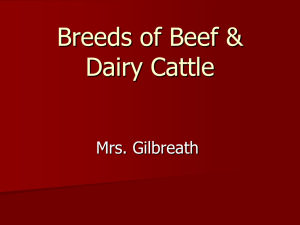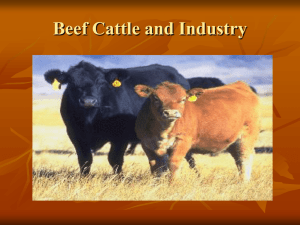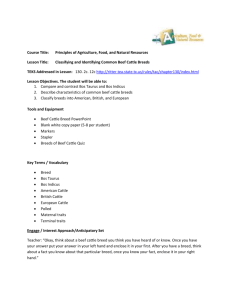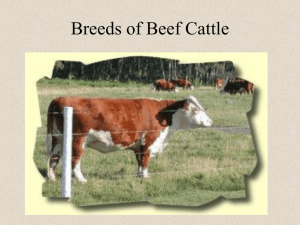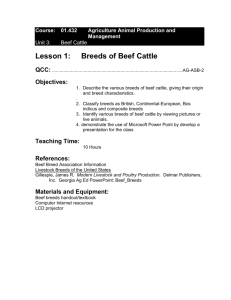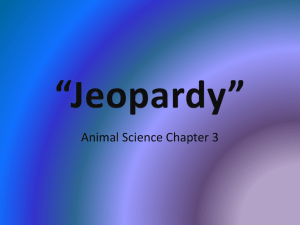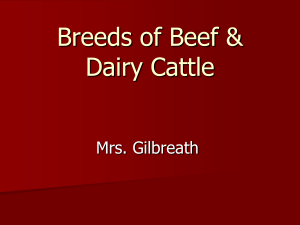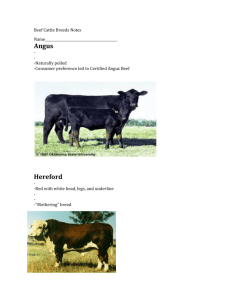Breeds of Beef Cattle
advertisement
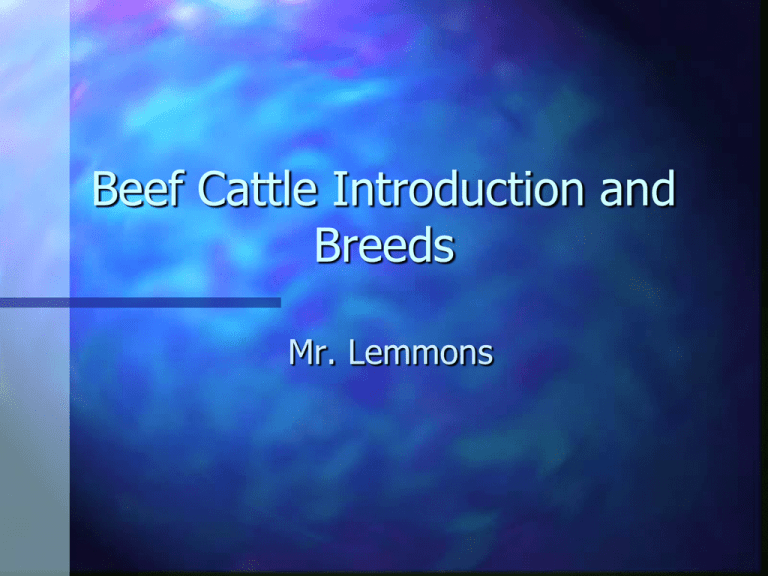
Beef Cattle Introduction and Breeds Mr. Lemmons Characteristics of the Beef Industry – Grain-fed Beef – most widely produced and tends to be less expensive. The cattle spend most of their lives eating grass in a pasture before moving to a feedlot where they are fed a high-energy, grain diet. – Grass-finished Beef – The cattle are raised on grass pastures. Characteristics of the Beef Industry – Certified Organic Beef –must be fed 100% organic feed and these cattle can not be given hormones to promote growth or antibiotics. *If antibiotics are needed they are not withheld but the animal must be permanently removed from the program. – Natural/Branded Beef – By definition, most beef is natural. According to the USDA “natural” may be used on a beef label if the beef does not contain artificial flavoring, coloring, chemical preservatives or any other artificial or synthetic ingredient. Producers raising cattle for beef marketed with a “natural” label may follow different production practices in order to brand their beef. Characteristics of the Beef Industry Segmented Industry 1. Cow/ Calf- commercial and purebred. They are the dictators of what's to come. 2. Stocker- Ranchers graze weaned calves until they weigh as much as 900 pounds, and then market them to the feedlots 3. Feedlot - Raises calves until they weigh 900 to 1,400 pounds and market them to packer operations 4. Packer - “enemy,” Take feedlot cattle, grade them, sent out as boxed beef. 5. Purveyor- distributor 6. Retailer - HEB, Kroger, Randalls 7. Consumer- $5-6+/ lb Characteristics of the Beef Industry Cow/ Calf – Ranchers produce the cattle for the stocker market or feedlot (commercial operation) or other breeding herds (purebred operation) – Texas = 13.6 million (ranks #1, makes up 14% of the total US beef) – Kansas = 6.57 million – Nebraska = 6.35 million Feedlot1. 2. 3. 4. Texas 2.6 million Kansas 2.2 million Nebraska 2.2 million Missouri 2.1 million Characteristics of the Beef Industry Breed Selection 2 Main Factors – 1. Genetics – 2. Environment Genetics – Determine advantages, disadvantages, then market ability. – Certified Angus Beef (50% Black, typical beef type, no floppy ear or hump larger than 4”, carcass avg choice or better, yield of 3 or better) Environmental – Geographical environment, management env. And personal preference Breed Selection Production Criteria 1. Mature Size - will it fit the environment? Do not outgrow your environment. 2. Milk production - as milking ability increases, the nutritional requirements increase. (Ex. Simmental) 3. Muscle Amount - as we increase muscling, fertility rate decreases. (higher muscle results in distocia in males and females) 4. Sexual Maturity - age at puberty, when is the 1st ovulation 5. Management efficiency - easy keeper, foraging ability 6. Biological Specie- Bos Indicus vs. Bos Taurus Bos Indicus vs. Bos Taurus Bos Indicus – Humped Breeds Advantages – Heat resistant – resistant to parasites Disadvantages – less adaptable to cold – lower reproductive efficiency Bos Taurus – Non Humped Breeds Advantages – Cold resistant – higher repro efficiency Disadvantages – heat tolerance low – susceptible to disease Breed Selection British/ English – Angus, Shorthorn, Red Angus, Hereford, Polled Hereford European/ Continental – Simmental, Gelbvieh, Salers, Maine Anjou, Chianina, Pinzgauer American – Brangus, Simbrah, Santa Gertrudis, Brahmousin, Beefmaster, Braford Hybrid Vigor – The crossing of 2 totally different breeds. – We calculate HV to give us an idea of heritability of traits (such as markings, muscle, milk, reproduction) F1 have the most expression HV Calculating HV (ww of offspring - Average ww of parents)/ average ww of parents *100 = %HV WW ww= weaning weight (the weight at which an animal is taken off of the milk from mother) Hybrid Vigor Example: Brahman Bull = 480 ww Hereford Cow = 500 ww F1 Calf = 525 480+500= 980/2 =490 (525- 490)/490 * 100 = 7.14% 7%HV *If the ww of offspring is less than the wt. of the best parent- crossbreeding is pointless. *High weaning weight is a plus- for any specie! Hybrid Vigor Example: <<<TRY THIS ONE ON YOUR OWN>>> Brahman Bull = 380 ww Angus Cow = 400 ww F1 Calf = 325 What is the % of HV? English/ British Breeds Angus Originated in Scotland Taurus solid Black or red Polled Came to America in 1873 resistant to harsh weather Early maturing Hereford Originated in Hereford, England Red with white head, legs, and underline Purebred Early maturing Good tempered 1817 Henry Clay Shorthorn Originated in England Red; red & white or roan in color Originally used as a dual purpose breed for meat and milk Sometimes called the Durham breed Simmental Originated in Switzerland Oldest breed of cattle in the world Large, powerful breed Brought to the United States in 1971 AKA: Fleck European Breeds Gelbvieh Originated in Germany Red in color, gold to rust Dual Purpose breed, milk and meat adaptable to broad range in climate 4 most numerous breed Noted for superior fertility and mothering ability Charolais Originated in France Traditionally white in color Long bodied, large cattle Heavily muscled Coarse looking Maine Anjou Originated in Northwest France Dark red with white markings or black Developed by crossing the Durham and Mancelle breed Bulls 2200- 3100# Name came from river valleys Chianina Originated in West Central Italy One of the oldest breeds of cattle Draft animals Tallest and largest breed of beef cattle Short hair that is white to steel gray, black Terminal breed high heat tolerance Brahman Originated in India Able to survive on very little, poor feed Insect & heat resistant Excess skin and large hump on back White to gray, red to black Sweat glands Pinzgauer Originated in Europe Red and white Austrian name good meat production Certified Pinzgauers have a white top line and white bottom line Salers Originated in South Central France Purebred milk and meat Typically Horned, polled red or black available. Depicted in cave dwellings 7k yrs ago. Survive in rough rocky terrain and harsh damp climates major contributor to American meat market Belgian Blue Originated in Europe Red and Black Pide with Shorthorn Taurus White, blue roan, some black, Double muscled Beef and milk late maturing, mild temper Limousin Originated in South Central France Indicus Golden red Sturdy and adaptable Dual purpose meat and work Butchers animal Isolated breed, genetic interference is not a problem American Breeds Polled Hereford Registered American Breed, Iowa 1901 Red and White body, brisket and underside Naturally horn-less developed as an idea Braford Originated in Florida 3/8 Brahman, 5/8 Hereford White face with red body and red eye patches Texas Longhorn Developed entirely by nature in North America Known for its long horns High fertility Were near extinction in 1927 Santa Gertrudis Developed on the King Ranch in Texas All Santa Gertrudis are descendants of the bull, “Monkey” 3/8 Brahman bulls, 5/8 Shorthorn cows hair is long in cold climates and short in hot climates Feedlot efficient Brahmousin American 3/8 Brahman, 5/8 Limousin Purebred Dark mahogany to light tan color at least 1/4 Limousin And 1/4 Brahman to be recorded Red Brangus Originated in So. Texas 3/8 Brahman, 5/8 Angus developed in 30’s Bulls breed till 10 yrs Cows till 14 yrs Simbrah Developed in humid areas along the Gulf Coast 3/8 Simmental, 5/8 Brahman Known as “The All Purpose American Breed” High fertility and Early maturing Beefmaster Originated Lasater Ranch, American 1/4 Hereford, 1/4 Shorthorn, 1/2 Brahman Brownish Red most common 6 essentials – Weight – Conformation – Milking ability – Fertility – Hardiness – Disposition Brangus Originated in US 1932, USDA experiment station in LA. 3/8 Brahman, 5/8 Angus solid black, can be red calves are large adaptable to all climates good mothering ability good feedlot efficiency
